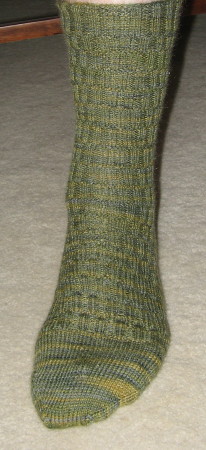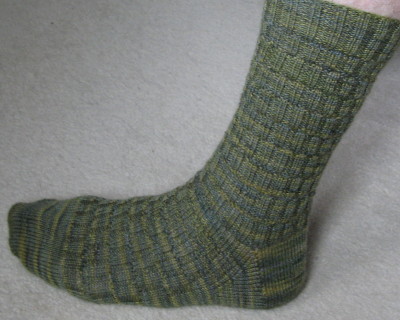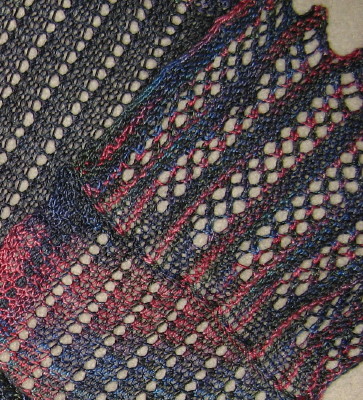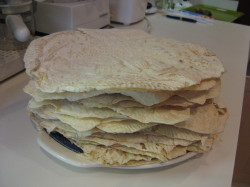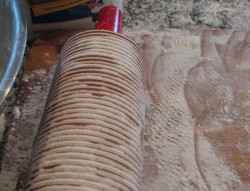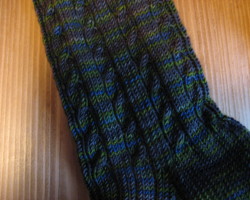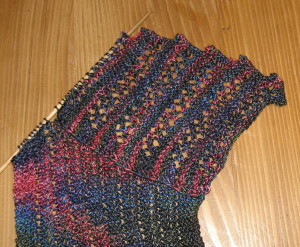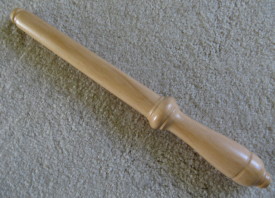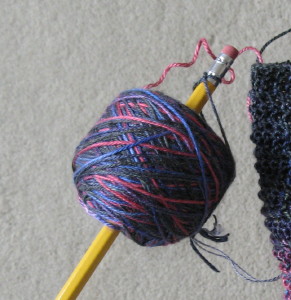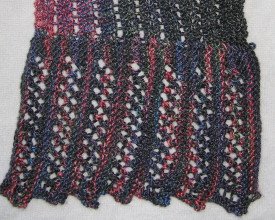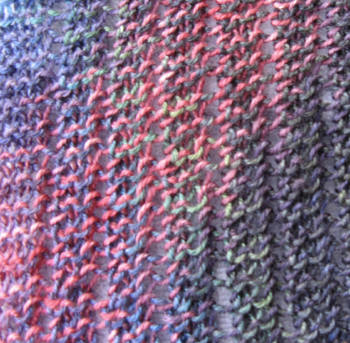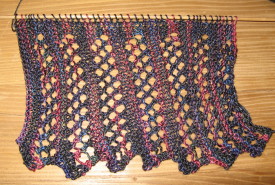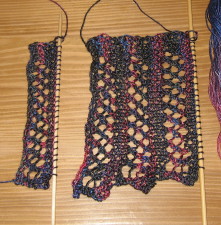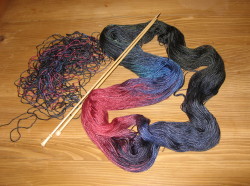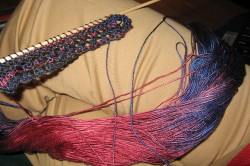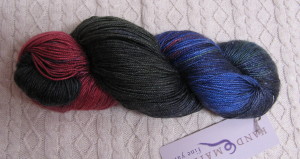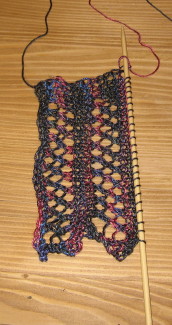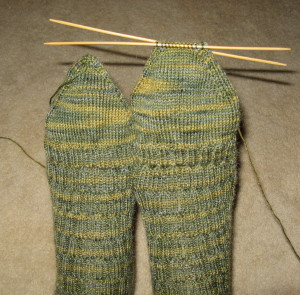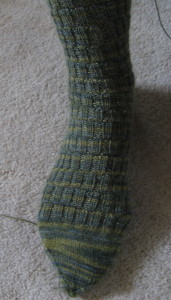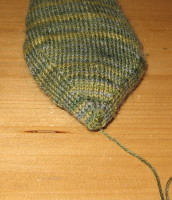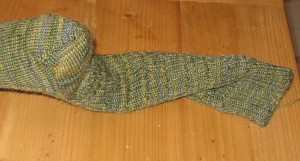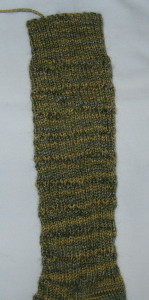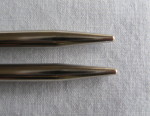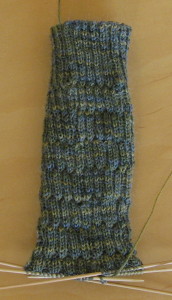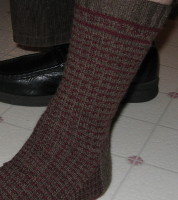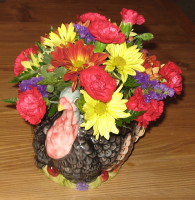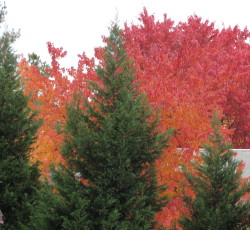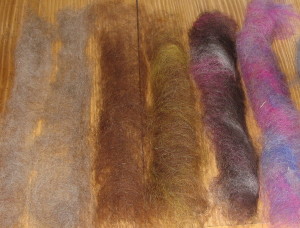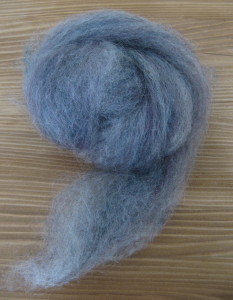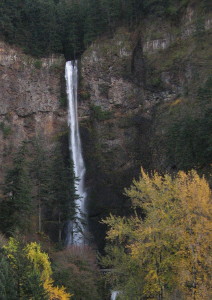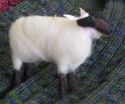Here at Yarnstruck Manor, we're having a pleasant New Year's Eve in, with wine and smoked salmon for celebration and fried oysters for luck. Strictly speaking, the fried oysters should have been for Christmas Eve, but the stores around here had run out. We'll just assume that a fried oyster make-up session before the end of the old year will still have the same effect!
There's also first-footing going on at Yarnstruck Manor tonight, but of quite a different sort. My brother's Christmas socks -- which I'm calling Knots and Rings -- are on hold awaiting the yarn for their contrast toes. I already had three other colorways of Socks That Rock Lightweight on hand, but none of them was right for the Knots and Rings socks, so those will have to bide their time. Meanwhile, though, I couldn't help but start on something new.
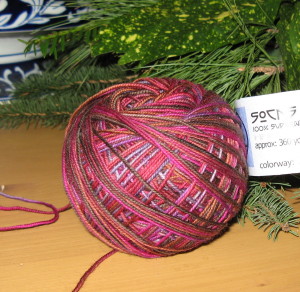 I'd been thinking of two of those three skeins for possible future presents to particular people, but this one wasn't spoken for. Time for a pair of socks for me!
I'd been thinking of two of those three skeins for possible future presents to particular people, but this one wasn't spoken for. Time for a pair of socks for me!I hadn't really thought about it, but of all the pairs of socks I've knitted over the years, only two pairs have been for me. And they were made of pretty basic yarns -- a little prickly, in fact -- before I discovered nicer ones.
So, with this yarn, I started yesterday on a pair of socks for myself. Working with this skein, the Socks That Rock yarn is starting to grow on me. It doesn't feel as formidable as the skein in Lagoon. It feels lighter, more flexible, actually a little bouncy with elasticity. It's really rather nice to knit with.
In talking with fiber people about spinning, I've been told that different colors of dyes can affect the texture of the fiber. In particular, they tell me that when wool rovings are dyed with blue and green colors, it can actually felt them slightly, making them a little harder to draft out for spinning. I wonder if there's some similar effect going on with the different dyes with this yarn.
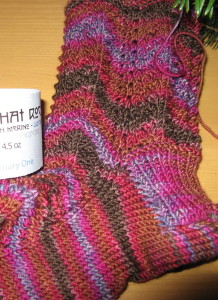 In any case, I began work on the Feather and Fan sock pattern from the Socks Socks Socks book. The first foot of this pair of socks will be the first new foot in our house in the New Year. Perhaps I should walk outside and carry it in over the threshold at midnight!
In any case, I began work on the Feather and Fan sock pattern from the Socks Socks Socks book. The first foot of this pair of socks will be the first new foot in our house in the New Year. Perhaps I should walk outside and carry it in over the threshold at midnight!I like the way the pattern is working with this yarn. This pair is going to be fun. (The color is closer to true in the photo above; the overall effect is not so rusty as this, and the color changes don't really look this jarring.) I'm looking forward to finding out for myself what it's like to wear a pair of merino wool socks.
 Now, what about that colorway? Yes, it's... January One. I swear I didn't plan it that way on purpose! But it's awfully appropriate for first-footing, don't you think?
Now, what about that colorway? Yes, it's... January One. I swear I didn't plan it that way on purpose! But it's awfully appropriate for first-footing, don't you think?Actually, I'm pretty certain that it's named after the January One blog of Cara, the founder and patron saint of the Spin-Out event held the last couple of years in the New York area. If so, I'm grateful to her for inspiring this colorway, because I'm really enjoying watching these colors paint themselves over the feather and fan pattern. And once they're socks, these colors couldn't help but be cheery on a winter's day.
I hope you're enjoying New Year's Eve as well. Lang may your lums reek! (Scots for: Long may your chimneys smoke!)
Happy New Year to all!

